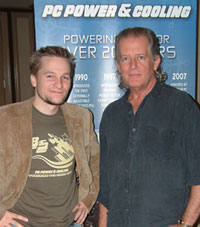Exclusive Interview with PC Power & Cooling Founder
by Christoph Katzer on February 11, 2008 3:00 AM EST- Posted in
- Cases/Cooling/PSUs
Not long ago we had a long talk with PC Power & Cooling founder Doug Dodson about power supplies and the question came up why there aren't lower wattage power supplies with enough PEG connectors to support higher end graphics card setups. The reason why will be answered shortly but Doug also agreed to build us a custom power supply based on the newly introduced Turbo Cool 860. The article about that power supply is already online, and as a follow-up we wanted to post this interview.

For the curious, that's Christoph on the left and Doug on the right…
We met Doug and the PC Power / OCZ crew at this year's CES show in Las Vegas, and he took the time to answer a few questions we had. We have three topics to cover: Technology, Markets, and Work. These will concentrate respectively on the technology offered by PC Power & Cooling, the newly extended markets created by the acquisition from OCZ, and how the work changed during this time until today.










49 Comments
View All Comments
mindless1 - Monday, February 11, 2008 - link
It applies just as much to generic manufacturers who sell 500W PSU for $15, knowing you'd have to pour some fuel in and light it to get 500W out for more than a moment.Olaf van der Spek - Monday, February 11, 2008 - link
> for ~98% of the desktop pcs, a quality 400W unit is more than enough.I think 150 W is enough if you use onboard video and 300 W is enough for a decent (8800 GT or Radeon 3870) video card.
mindless1 - Monday, February 11, 2008 - link
Those figures are only enough if you're an OEM with control over a standardized platform so you know the current per rail the system use and can then spec the PSU current per rail you need.Otherwise, consider some recent P4 CPUs produced 110W+ themselves, running off a (roughly) 93% efficient VRM subcircuit on a motherboard that would already be 118W. Will 32W be enough to run the whole motherboard, a hard drive, optical drive, maybe one expansion card? Doubtful, many motherboards use this much by themselves.
300W is a lot more breathing room, since most with a video card don't buy 300W PSU if it's a higher end card and why should they really? If their budget includes $150+ for a midrange or better video card they shouldn't really be thinking along the lines of paying only $30 or less for a PSU to power it all, especially when the PSU is the least likely to be obsolete within 18 months so it might be reused.
Olaf van der Spek - Tuesday, February 12, 2008 - link
> Otherwise, consider some recent P4 CPUs produced 110W+ themselves,Those P4s have never been a good choice.
tynopik - Monday, February 11, 2008 - link
b/c it only has a pathetic 6 peripheral and 4 sata connectorsbump it up to 10 and 6 and i might consider it
JarredWalton - Monday, February 11, 2008 - link
It goes back to marketing. NVIDIA and AMD have requirements for SLI/CrossFire certification, and you can't easily market a PSU as a high-quality unit unless it has SLI/CF support. So, you need to meet their requirements (1100W for Tri-SLI and 550W? for SLI), which means pretty much all PSUs these days worth considering start at 550W or more.Olaf van der Spek - Monday, February 11, 2008 - link
> So, you need to meet their requirements (1100W for Tri-SLI and 550W? for SLI),Looks like a requirement for the marketing department, not for the technical department.
Don't AMD and nV have any sense when it's about power?
JarredWalton - Monday, February 11, 2008 - link
Doug explains this in the article. A crappy PSU from a generic brand that says 450W isn't going to work with SLI, and many users don't know the difference between good and lousy PSUs. So, to be safe they figure a crappy 600W PSU can run SLI, so they "require" a 600W PSU for SLI. The reality is that your typical SLI rig won't even draw more than 300W, and triple-SLI is under around 600W (without overclocking).You may not be susceptible to marketing, but about 90% of the market is unfortunately.
NicePants42 - Monday, February 11, 2008 - link
You hit Doug for noise on the Turbocool 1200, and he fires back with 50C ambient requirements - isn't it time someone mentioned water?!OCZ did hybrid air/water cooling for RAM, and RAM is already silent. The guys blowing money on Triple-SLI rigs are the same guys blowing money water cooling them for silence. How long will PCP&C keep designing 80mm jet engines?
mindless1 - Monday, February 11, 2008 - link
There are many different PSu configs out there to suit many different needs. It would be terrible if everyone changed their designs to suit your one ideal because that one ideal is subjective to your needs.If your system uses little enough power that it can run a PSU at acceptible lifespan using low air volume, the Turbo 1200 wasn't right for your needs.
Just moving up to 120mm fan doesn't magically keep noise low when talking about even an optimistic 85% efficiency at 1200W which is close to 210W of heat it has to remove, and that when at it's rated 50C ambient. Your CPU isn't likely to be in 50C ambient, 210W heat, and run ok from a quiet heatsink fan either.